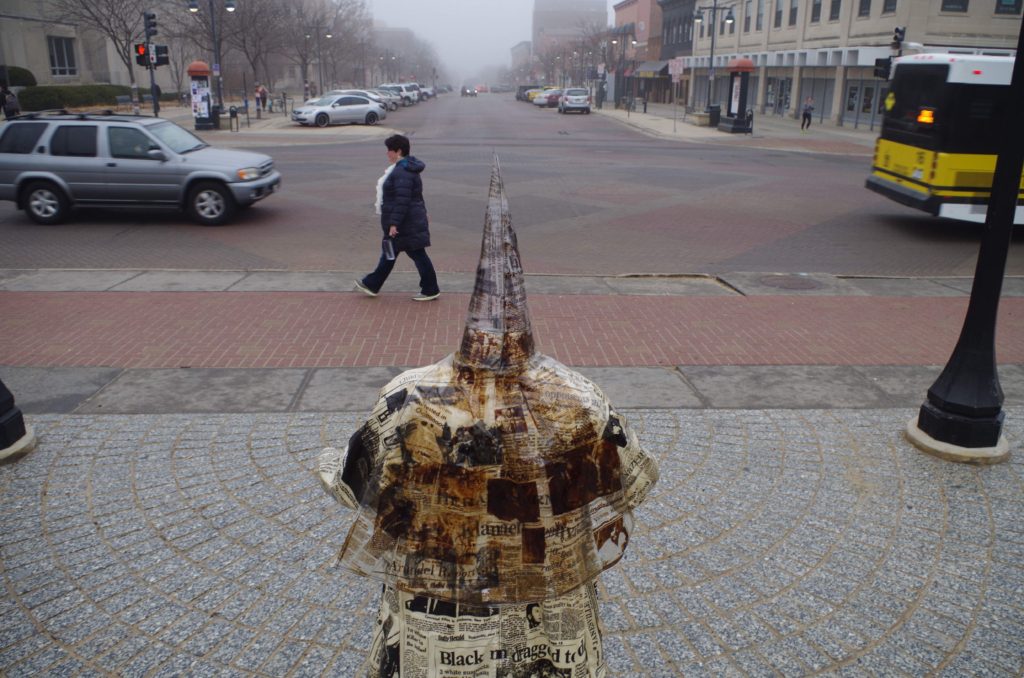Sally Mason, spokesmen could benefit from sunlight
Last Friday morning, as I turned the corner of Clinton and Washington streets en route to a breakfast meeting, a figure on the Pentacrest caught my eye. It was early and still foggy as I stared, my brain racing to register what it was seeing. I flipped through scenarios: a mostly white trench coat, maybe a homeless person, a lighthearted holiday sock-top with an elven point at the top.
Bile rose as I moved forward, seeing the shape of a person in the ceremonial garb of white supremacists. Anger percolated. Hateful scenes, talk and writing from my past in the South flickered. A sign on a country road announcing a curfew, punishable by death, for people of color. Students teasing a new white classmate upon discovery his family lived at “monkey island,” the ugly name given to the subsidized apartment complex in my hometown where many families of color lived. Walking to and from school instead of allowing a black peer, the son of family friends, to provide a lift; knowing I’d be verbally ostracized for the contact, but he could be hurt.
By the time I circled around to approach the vile figure from the rear, the only sound I heard was my own blood pumping. Then I stopped, once again confused by a strange newsprint cloak and coat rack feet.

Not knowing exactly what I was seeing, but understanding the most worrisome of my guesses was unfounded, a nervous and relieved giggle escaped. I made a mental note to walk back after breakfast, take a couple of photos and then search for more information about what I assumed was street art.
The rest of the story surrounding the artwork on the University of Iowa campus that transfixed and shocked me and others is a public rather than personal account.
Only a few hours later, campus police surrounded the figure and forcibly removed it. Without the blessing of the university, it had been placed on the Pentacrest by the artist, who said the piece was created to serve as a catalyst for discussions on race in America.
Based on my own initial reaction, and that expressed by others, kudos are due to the artist, visiting assistant UI professor Serhat Tanyolacar. Mission accomplished, sir.
While tales of the unusual morning might have ended here, university spokesmen chose instead to pick up the threads of misplaced outrage and amplify them to a dangerous juxtaposition to the First Amendment.
Tom Rocklin, vice president of student life, wrote in communications with students that “the UI respects freedom of speech,” and that “the university is also responsible for ensuring that public discourse is respectful and sensitive.”
What a slice of rancid baloney. The university, like other institutes of higher learning, is under no obligation to keep students from what some may feel is objectionable content. In fact, some would argue it is the university’s duty to purposefully expose students to artwork and perspectives that provoke strong emotions and thought, however unpleasant.
UI’s initial official statement regarding the incident and President Sally Mason’s follow-up also depicted the artwork (and for all practical purposes the artist as well) as racist, needlessly irritating the feelings and memories evoked by the art. Mason went as far as to dub the unauthorized display an act of terrorism, saying the artwork “immediately caused black students and community members to feel terrorized and to fear for their safety.”

Please divert your attention from the nine reported sexual assaults on campus this year, and enjoy the show as university officials flex their “tough on crime” muscles in front of this inanimate artwork. Feel better? Safer?
All-in-all, December has turned out to be a fairly uncomfortable month for Mason and other university officials, although they should have seen it coming.
The Daily Iowan, the independent student-run, non-profit newspaper that serves the campus and wider community, made clear in a lengthy opinion piece that Mason has decided to break tradition and treat the DI as it would any other news outlet. Although university presidents have, for years, agreed to organized sit-downs with DI reporters, the practice was discontinued last February when a statement by Mason regarding sexual assault was scrutinized by campus groups and other media outlets.
Keep in mind that the sit-downs were customary and organized, meaning that university officials and DI staff had an agreed-upon list of discussion topics. Mason was not unexpectedly sideswiped by a rogue reporter asking about sexual assaults when she made her now controversial comment; she knew well before the interview what would be discussed.
The university, according to DI Editor Jordyn Reiland, then attempted to restructure the paper’s access to Mason by outlining how information from the sit-downs should and should not be used. In a time when many in the public eye claim their words have been taken out of context, Mason’s team suggested there was no need for full transcripts to be published.
There are some who will argue all newspapers should have equal access; that the student-run paper should be given no more perks than what is provided my colleagues at The Gazette or reporters from the Des Moines Register. Local officials have a vested interest in fostering and nurturing open-door policies with their local media outlet. In the case of the university, especially in terms of the student population, the DI is the local media outlet. Student journalists have an unqualified interest in how the university is run, what its leaders think and believe, and serve as a direct link to the population that most needs to question and be provided answers.
While co-workers at The Gazette are considering how a policy change by the Regents will impact the state, the universities, the taxpayers, etc., student journalists at DI have a specialized focus on how the policy will affect their audience.
By listening and responding to reporters who speak on behalf of this niche audience, university officials can be better informed and alerted to potential problems and unease. In other words, if sexual assault were not an issue on campus, it likely would not be an agreed upon topic at a sit-down with Mason.
Perhaps, if Mason had been meeting with DI reporters, she and her staff would have been more in tune with the student population, and better prepared to remove unauthorized artwork without stooping to name calling or First Amendment infractions. She may have been more aware of students forming alliances of distrust in the wake of violence and unrest in Ferguson and Staten Island. She and her staff may not have foolishly and irrevocably squandered positions of influence.
Things appear differently when shrouded in fog. University leaders should move forward and see what a little disinfecting sunlight can accomplish.
This column by Lynda Waddington originally published in The Gazette on Dec. 14, 2014. Photo credit: Mitchell Schmidt/The Gazette and Stephen Mally/The Gazette
